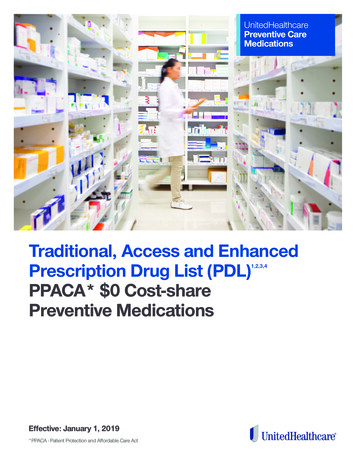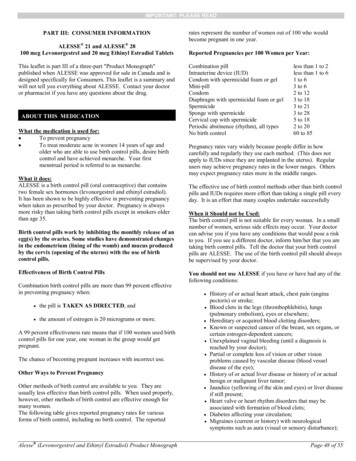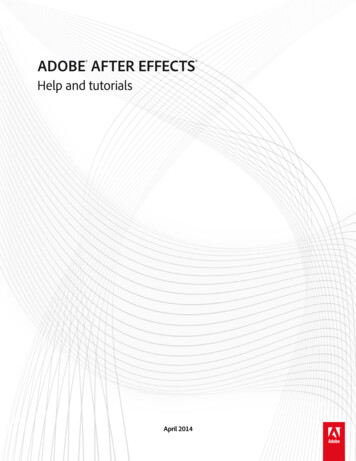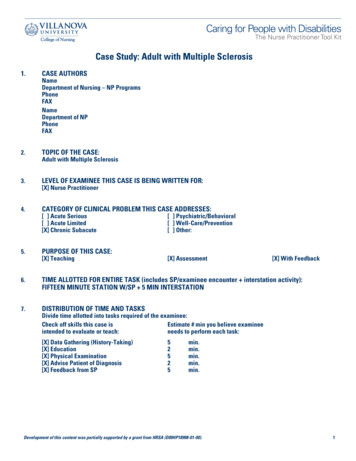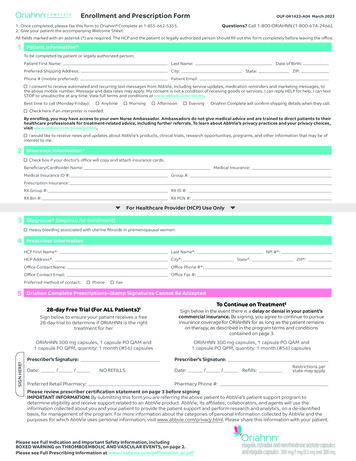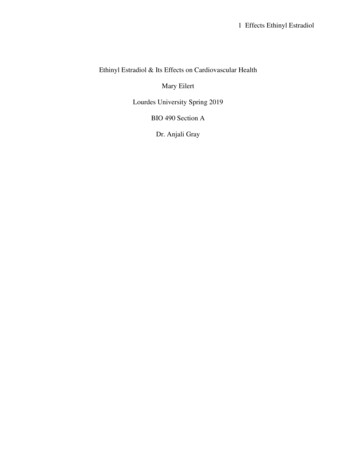
Transcription
1 Effects Ethinyl EstradiolEthinyl Estradiol & Its Effects on Cardiovascular HealthMary EilertLourdes University Spring 2019BIO 490 Section ADr. Anjali Gray
2 Effects Ethinyl EstradiolABSTRACTCombined hormonal birth control regulates the menstrual cycle in women by manipulating thehormonal level. Combined hormonal contraception utilizes progestin and Ethinyl estradiol,which are synthetics of progesterone and estrogen. These synthetic hormones help regulateovulation in women and in turn menstruation. Venous thromboembolism (VTE), stroke, andmyocardial infarction are all risk factors when taking combined hormonal contraception due tothe chemical composition of Ethinyl estradiol. Ethinyl estradiol’s binding mechanism to anestrogen receptor causes clots and therefore a risk for cardiovascular disease. The dosage ofEthinyl estradiol is related to an increased risk for VTE, stroke, and myocardial infarction. Dueto the increased threat to cardiovascular health, physicians should screen patient health historycarefully when prescribing combined hormonal birth control. Analyzing the risk Ethinyl estradiolposes to cardiovascular health in women can be used to determine if combined hormonal birthcontrol is the ideal choice for contraception.
3 Effects Ethinyl EstradiolINTRODUCTIONBirth control, a contraceptive, is frequently prescribed to women of varying agesthroughout the United States. Birth control can be used for its primary use as a contraceptive orprescribed as a means of lessening symptoms of reproductive diseases, such as endometriosis.Birth control comes in various forms and methods. Intrauterine devices (IUDs) and birth controlimplants are forms which are implanted into the women and rely on the release of hormones toregulate the menstrual cycle (Planned Parenthood). These methods are considered long termsince they do not have to be monitored as often as other methods. Short-term methods of birthcontrol include the shot, birth control pills, and the patch (Planned Parenthood). These methodsare short-term due to having to take, or replace, the form of birth control daily or weekly. Themethods also rely on the use of hormones to regulate the menstrual cycle and thus, preventpregnancy. Other forms of birth control exist which do not rely on hormones - these methods,however, must be used during every sexual encounter and often several methods are used at onceto prevent pregnancy. These methods include a male condom, a diaphragm, cervical caps,Natural Family Planning, and many more. These methods will not be focused on due to the lackof hormones.Many women are put on hormonal birth control at a young age and are kept on themedication for most of their life. With so many women exposed to hormonal regulation for sucha prolonged period of time, it requires further research and information on how thosemedications will affect a woman’s cardiovascular health. After analyzing the research, it can bedetermined whether physicians should alter their treatment methods, either by switching fromhormonal to nonhormonal birth control, changing the type of hormonal birth control, or if thetreatment methods should be left unaltered.
4 Effects Ethinyl EstradiolFigure 1. Guttmacher Institute 2014 DataAccording to a 2014 study done by the Guttmacher Institute, Figure 1, it was found that 9, 572,477 women use the pill form of birth control, which is around 15.6% of women ages 15-44 in theUnited States, while 1,481,902 women, or 2.4%, use the injection form of hormonal birthcontrol. According to the Guttmacher Institute most women begin using birth control around age15, and continue until age 44. If a woman were to use hormonal birth control for that entireduration, that would be 29 years that woman would be subjected to potential health risks fromhormonal birth control.PHYSIOLOGY OF MENSTRUATIONHormonal birth control regulates the menstrual cycle to prevent pregnancy. Themenstrual cycle is a monthly occurrence of fluctuating hormones in a woman’s body. The first
5 Effects Ethinyl Estradiolmenstruation, menarche, begins around 11-12, and continues throughout life until menopause,the end of menstruation, around ages 45-55 (Martini and Nath 2011). Menstruation begins on theday of the period. The Cleveland Clinic lists four different phases as part of menstruation:Phase 1 of menstruation: the menses phase - this phase can last anywhere from 1 to 5 days and itis the time when the lining of the uterus is shed out of the vagina if fertilization of the egg hasnot occurred.Phase 2 of menstruation: the follicular phase - the levels of estrogen rises, which causes theendometrium of the uterus to grow and thicken. Follicle-stimulating hormone (FSH) levels alsoincrease during this phase, which causes the follicles in the ovaries to grow. This phase lastsfrom days 6-14.Phase 3 of menstruation: the ovulation phase - ovulation occurs when luteinizing hormone (LH)triggers the release of the egg from the ovary. This lasts from days 14-28.Phase 4 of menstruation: the luteal phase - during this phase the released egg travels through theuterine tubes and at the same time the level of the hormone progesterone rises. This phase lastsfrom days 15-28. The rising level of progesterone prepares the lining of the uterus for pregnancy.Pregnancy occurs when the egg is fertilized by a sperm and attaches to the uterine wall. Whenthis does not occur, estrogen and progesterone levels decline and phase 1 of menstruation begins.There are several important hormones involved in menstruation: Follicle Stimulatinghormone (FSH), Luteinizing hormone (LH), Gonadotropin releasing hormone, estrogen, andprogesterone (Martini and Nath 2011). Gonadotropin releasing hormone is the hormone forstimulating the menstruation process. While all these hormones are significant to menstruationand its process, only estrogen and progesterone are used in hormonal contraception to preventmenstruation. Estrogen and progesterone are naturally occurring hormones that typically do not
6 Effects Ethinyl Estradiolexhibit negative side effects in the body. However, hormonal contraception uses synthesizedversions of these hormones. The synthesized estrogen and progesterone differ from theirnaturally occurring counterparts in their chemical geometry. Due to this variance in chemistry,the synthesized hormones are not processed in the same way as the naturally occurringhormones.CHEMISTRY OF PROGESTINIn 1951, Carl Djerassi synthesized Norethindrone, the first progestin (Gebel Berg 2015).Progestin is the synthetic version of the steroid hormone, progesterone. Progesterone is derivedfrom cholesterol, so when chemists first started synthesizing progestin, they added hydrophilicfunctional groups to the molecule. This allowed the progestin to be readily absorbed from theintestine to the bloodstream, instead of binding to lipids in the intestine. Progestins inhibitovulation by blocking the progesterone receptor. However, progestin also tends to bind toandrogen and glucocorticoid receptors. Androgens are the hormones responsible for malereproductivity and secondary sex characteristics (Davey, Grossmann 2016). Females haveandrogen receptors because females still require low levels of androgens. The binding ofprogestin to an androgen receptor can cause an increase of acne and decrease the high-densitylipoprotein cholesterol, HDL. Progestin bound to a glucocorticoid receptor can cause bloating bytriggering retention of salt and water. Glucocorticoids are steroids responsible for theinflammatory response (Gensler 2013). These are typical side effects seen when taking birthcontrol and do not pose a risk to overall health. The early progestin molecules, likenorethindrone, were derived from testosterone with the only goal of the molecule being to inhibitgonadotropin receptors. The intention was to block gonadotropin receptors so that theGonadotropin Releasing hormone could not bind and release the hormones to prepare for
7 Effects Ethinyl Estradiolpregnancy. The main issue with those molecules was that they tended to inhibit other steroidreceptors as well. Since then, chemists have been synthesizing molecules with reduced receptorpromiscuity to reduce side effects. The goal was to synthesize a progestin that has the chemicalgeometry of progesterone to reduce negative side effects. Many of the side effects have beenreduced since the first progestin, but blood clots are a prominent issue. This is due to estrogen,not progestin. Pills and injections containing only progestin reduce the risk of pregnancy byseveral methods. The progestin causes the mucus in the cervix to thicken, making it difficult forsperm to move into the uterus. If sperm cannot surpass the cervix then it cannot fertilize the eggin the uterine tube. However, progestin inhibits ovulation inconsistently. Around 40% of womenon progestin-only pills still experience ovulation (American College of Obstetricians andGynecologists 2018). If ovulation does not occur then an egg is not released form the ovary andtherefore cannot be fertilized. Progestin also thins the lining of the uterus. If the lining of theuterus is too thin, it cannot properly house a fertilized egg, therefore preventing pregnancy.CHEMISTRY OF ESTRADIOL & ETHINYL ESTRADIOLEstrogen is found in combination pills, or contraceptives with both progesterone andestrogen. Estrogen receptors can be found in the liver. These receptors promote blood clottingfactors - Ethinyl estradiol, the molecule found in combination pills, is far more potent thannormal estradiol, and therefore remains in the system for an increased time frame. By remainingin the system longer, ethinyl estradiol activates the liver pathway and thus promotes bloodclotting (Gebel Berg 2015). The difference occurs in the molecule’s makeup.
8 Effects Ethinyl EstradiolFigure 2. Ethinyl Estradiol (Ethinyl Estradiol Pubchem)Figure 3. Estradiol (Estradiol Pubchem)Ethinyl estradiol, Figure 2, varies from estradiol, Figure 3, in its chemical structure. Thisvariance results in the different metabolism of each molecule. As pictured in Figure 2, Ethinylestradiol has a triple bond on carbon 1 of the pentane ring of the molecule. In estradiol, Figure 3,there is a hydrogen bonded to carbon 1 of the pentane ring instead of a tripled bonded carbon.
9 Effects Ethinyl EstradiolThe presence of the alkyne, the triple bond between two carbons, is the reason Ethinyl estradiolremains in the system for a longer time that estradiol. The alkyne bond on Ethinyl estradiol mustbe broken down through oxidation. This will lead to estradiol and some carboxylic acid sideproducts (Reusch 2013). Ethinyl estradiol activates the clotting pathway due to the process bywhich it bonds to the estrogen receptor in the liver. The estrogen receptors are located within thenucleus in a cell - estradiol typically diffuses into the cell and binds there. However, Ethinylestradiol is too large a molecule to diffuse into a cell to reach the estrogen receptor in thenucleus. Instead, Ethinyl estradiol binds to an estrogen receptor located in or adjacent to theplasma membrane. When this binding occurs, it stimulates the release of Ca2 , calcium (Derooand Korach 2006). Calcium is one of the main factors involved in the clotting process. Byincreasing calcium, the risk of forming clots increases.
10 Effects Ethinyl EstradiolFigure 4. Estrogen Receptor (Deroo & Korach 2006)Figure 4 depicts the different binding pathways that can occur at an estrogen receptor.The pathway labeled “i” is the classical pathway. The classical pathway occurs when estradiolbinds to a receptor in the nucleus of the cell. Pathway “ii” is the pathway typically used byEthinyl estradiol. In pathway ii, the estrogen receptor is located in or adjacent to the plasma
11 Effects Ethinyl Estradiolmembrane instead of the nucleus. Calcium, nitrous oxide, and kinases are released when thisbinding occurs.Combined hormonal methods present an increased risk for deep vein thrombosis (DVT),heart attack, and stroke (American College of Obstetricians and Gynecologists 2018). Theserisks are associated with increased blood clotting factors, due to ethinyl estradiol being the activeestrogen molecule in combined hormonal methods (American College of Obstetricians andGynecologists 2018). The presence of Ethinyl estradiol increases the risk for cardiovasculardisease in women.VENOUS THROMBOEMBOLISMThe release of calcium through the binding of Ethinyl estradiol to an estrogen receptorresults in the formation of a clot. That clot buildup can then present the risk of venousthromboembolism. Venous thromboembolism, or VTE, is the formation of a clot that carriesblood back to the heart (National Heart, Lung, and Blood Institute). One of the first recordedincidences of VTE in relation to hormonal birth control was in 1961 (Thacker 2014). A nursewas taking combined hormonal contraception with an estrogen dosage of over 50 µg. Shesuffered from a pulmonary embolism as a result. Increasing incidences of reported strokes andmyocardial infarctions in women using combined hormonal birth control was observed in yearsfollowing the original incident (Thacker 2014). Since 1961, the dosage level of Ethinyl estradiolhas decreased to around 25 µg per dose (Thacker 2014). However, though the dosage of Ethinylestradiol has decreased there is still risk of VTE or myocardial infarction when taking combinedhormonal contraception due the release of Ca2 when Ethinyl estradiol binds to an estrogenreceptor.
12 Effects Ethinyl Estradiol“Analysis of Risk Factors of Stroke and Venous Thromboembolism in Females with OralContraceptive Use” was a study conducted from 1997 to 2014 that analyzed the risk for VTE andstroke in two different groups of women (Dulicek et al 2018). The groups of women studiedwere as follows: one cohort consisted of 70 women who had suffered a stroke, and the othergroup consisted of 700 women who had suffered VTE. The mean ages for the groups were 26 forthe stroke group, and 29 for the VTE group. The mean duration for combined hormonalcontraceptive usage was 48 months and 45 months, respectively. Each woman provided a familyhistory of thrombosis and details of their smoking habits.Of the 70 women in the stroke cohort, 20 had a thrombophilic disorder. Thrombophilia isthe overactive clotting in blood (Cleveland Clinic 2018). 13 of the 70 women had an ischemicstroke- of the 13, 3 had a thrombophilic disorder. 17 of the 70 women had a transient ischemicevent- of those 17, 2 had a thrombophilic disorder. An ischemic stroke is when the artery thatprovides oxygenated-blood to the brain becomes blocked, often by a blood clot. A transientischemic event occurs when the artery providing oxygenated-blood to the brain is only blockedfor a small period time (Center for Disease Control and Prevention 2018). Transient ischemicattacks often prelude ischemic strokes. In the study it was noted that the women in the strokegroup displayed a higher frequency of smoking than the women in the VTE group.Of the 700 women in the VTE group, 385 of the cases were considered spontaneous. Thismeant that 55% of the cases in the VTE group had no additional trigger. 315 of the patients,however, reported provoking factors that triggered VTE onset. Those factors included longtravel, immobilization, surgery arthroscopy, plaster casts, calf injuries, or strenuous sportactivity. Additionally, at the time of the VTE occurrence none of the women had been onthromboprophylaxis. 313 women of the whole 700 were diagnosed with thrombophilia. Of those
13 Effects Ethinyl Estradiol313 women, the presence of thrombophilia was higher in those with spontaneous VTE than thosewith provoked VTE- 56.3% versus 30.4%, respectively. The study gave a set of guidelines forphysicians to follow to reduce the risk of VTE and stroke in association with combined hormonalbirth control. The guidelines are:1. Record any family/personal history of thrombosis and assess in association withadditional risk factors.2. Record any symptoms of a thrombotic event such as stroke, myocardial infarction(heart attack), and VTE.3. Use of thromboprophylaxis with Low Molecular Weight if the patient presentsadditional risk factors.The study came to the conclusion that combined hormonal contraception was not asignificant risk to health as long as the patient did not smoke or present thrombophilia, and thatthe patient attended regular checkups to monitor her health. The provoked VTE cases were in theminority for occurrence, and the guidelines recommend to use thromboprophylaxis in associationwith combined hormonal contraception to reduce this risk for the patient. Women who smokewere at a higher risk for stroke while on combined hormonal contraception.The results of the VTE and stroke study illustrate that a physician needs to exercisecaution when prescribing combined hormonal contraception. A patient’s health history needs tobe carefully checked to see if there are any risk factors that could increase their chance for VTEor stroke. If a patient does have history of a thrombophilic disorder it would be a safer decisionto prescribe a progestin-only contraception instead of combined hormonal contraception. Theevidence from the study shows that taking combined hormonal contraception increases the riskfor VTE if the patient has a thrombophilia. The best option would be to eliminate that risk by
14 Effects Ethinyl Estradiolputting that patient on progestin-only pills, or an alternate form of birth control that does notutilize estrogen. The patient’s risk for VTE is therefore not increased by an easily preventablemeasure. In addition, those who smoke should be discouraged from using combined hormonalcontraceptive due to the increase of stroke seen in women who smoke and take combinedhormonal contraception. Physicians should recommend taking progestin-only contraception forthose patients who smoke. However, in patients who do not smoke or possess thrombophilia,combined hormonal contraception can be a safe choice. The risk for VTE or stroke is highestduring the first month of medication. During that month the risk factors for a healthy,nonsmoking woman taking combined hormonal contraception are the same as the risks posed byunintended pregnancy.From 1976 to 2016 a Nurse’s Health Study was conducted to observe the effects ofhormones on health. The study was broken up into NHS and NHS II, as the first group consistedof older women, 30 years and up, and the NHS II group consisted of younger women ofreproductive age. Each participant was questioned about their hormone use, whether it be oralcontraceptives or hormone therapy for menopause. The study consisted of two groups: NHS andNHS II. The NHS group was made up of women aged 30-55 years. NHS II was made up ofwomen younger than 33 years to include those who started taking combined hormonalcontraception during adolescence or early adulthood. The study found that in the NHS there wasan overall increased risk for myocardial infarction and an increased risk for women who arenonsmokers for myocardial infarction as well. The NHS group was also seen to have anincreased risk of pulmonary embolism, though this risk was not seen in those women whostopped using oral contraception. In the NHS II group, there was some evidence that oralcontraception decreases the risk for gestational hypertension but that it could possibly increase
15 Effects Ethinyl Estradiolthe prevalence of preeclampsia, though more research would need to be conducted on that frontfor clearer results.The study also included results for the risk of cancer when taking combined hormonalcontraception. Though cancer is not linked to cardiovascular health, it is important data thataffects woman’s health. NHS and NHS II premenopausal women were seen to have an increasedrisk for breast cancer, however, that was only for current users. Past users of oral contraceptiondid not appear to have an increased risk for breast cancer. There was an observed decrease in therisk for both ovarian and colorectal cancer in the NHS group among users of oral contraception.There was no observed increase risk in the NHS II group for colorectal cancer, but there was alsonot an observed decrease in the risk either. There was an observed increase for the risk formelanoma in both the NHS and NHS II groups among current users of oral contraception(Bhupathiraju et al 2016).
16 Effects Ethinyl EstradiolFigure 5. Nurse’s Health Study Data (Bhupathiraju et al 2016)The results of the study demonstrate that there are several more factors to consider whenprescribing birth control to a patient. First, a detailed medical and family history needs to beobtained so the physician has all information needed when prescribing. History of cancers shouldalso be considered- if a patient has extensive or frequent occurrences of breast cancer in familyhistory, it would be a more ideal choice for a physician to recommend a progestin-only pill toavoid an increased risk for breast cancer. The same line of reasoning should be used for thosewith history of melanoma. Likewise, caution should be exercised when prescribing oralcontraception for those with a history of cardiovascular disease, due to the increased risk ofpulmonary embolism and myocardial infarction. In these groups, alternative methods would bebest to put the safety of the patient above that of the convenience of the medication.
17 Effects Ethinyl EstradiolIn 2012, the New England Journal of Medicine published a Danish study that observedthe relation between thrombotic stroke and myocardial infarction in women using hormonalcontraception. “Thrombotic Stroke and Myocardial Infarction with Hormonal Contraception”was conducted from 1995 to 2009 and had a population of 1,626,158 women with no history ofcardiovascular disease or cancer. Among that population there was an occurrence of 3311thrombotic strokes and 1725 myocardial infarctions. The study found that the incidence of strokeand myocardial infarction was lower at an Ethinyl estradiol dosage of 20 µg compared to adosage of 30 or 40 µg. The risk factor of thrombotic stroke and myocardial infarction increasedby a factor of 1.3 to 2.3 when the dosage of Ethinyl estradiol was increased from 20 µg to 30 or40 µg.
18 Effects Ethinyl EstradiolFigure 6. Thrombotic Stroke Myocardial Infarction DataFigure 6 is the data obtained from the study. The study varies from the others discussedbecause it includes which type of progestin was used in combination with Ethinyl estradiol. Thedata table compares the rate of incidence and relative risk for myocardial infarction and
19 Effects Ethinyl Estradiolthrombotic stroke based on dosage of Ethinyl estradiol and which progestin it is combined with.The results of the table show that an increased dosage of Ethinyl estradiol leads to a significantlyhigher risk of thrombotic stroke and myocardial infarction.CONCLUSIONSFrom the evidence of multiple studies including those discussed here, the risk of venousthromboembolism poses the biggest threat to women’s health while they are on combinedhormonal contraception. It was observed that VTE and stroke were among the most significantrisk factors, along with myocardial infarction. Patients with a medical history of thrombophilia,or any other risk factor that could contribute to the incidence of VTE, stroke, or heart attack needto exercise the greatest caution when taking hormonal contraception. Progestin-only methodspose significantly less risk than combined hormonal contraception. The binding of Ethinylestradiol to the estrogen receptor results in the release of calcium, which leads to increased riskof clots. Increasing the risk of clots in turn increases the risk for VTE, stroke, or myocardialinfarction. Taking combined hormonal contraception presents this risk, since Ethinyl estradiol isone of the pills main components. Patients with an increased risk of VTE, stroke, and myocardialinfarction by medical history should be prescribed progestin-only contraception or alternativemethods of contraception so that the patient’s risk for VTE, stroke, or myocardial infarction willnot increase. Patients who do not posses any history or risk factors for stroke, VTE, ormyocardial infraction but do posses history of cancer, especially breast cancer, should be advisedto avoid using combined hormonal contraception. Hormonal contraception has been observed toraise the risk of breast cancer and melanoma. Women with those histories should not usecombined hormonal contraception, or if they do, they should be warned of the risk thataccompanies using the medication.
20 Effects Ethinyl EstradiolMany women, however, do not take hormonal contraception purely for the purpose ofpreventing pregnancy- many women take hormonal contraception to regulate menstruation, toalleviate painful menstruation, or to reduce the symptoms of certain reproductive diseases, suchas endometriosis. Older women use estrogen to help regulate the effects of menopause. In theseinstances, progestin-only contraception provides a less effective regulation of symptoms thancombined hormonal or estrogen. Patient history becomes pertinent to treatment. For women whohave a form of thrombophilia and wish to take to combined hormonal contraception, the use ofthromboprophylaxis in association with the birth control is important to prevent a clot, whichcauses VTE, stroke, or myocardial infarction. Women who use estrogen for regulation ofmenopause who are at risk for breast cancer are also at high risk, and their physician shouldconsider alternative routes to decrease risk for the patient.For patients with no history of VTE, stroke, myocardial infarction, breast cancer ormelanoma, combined hormonal contraception can be a safe choice to use to prevent pregnancyor regulate symptoms. Combined hormonal birth control presents the same risks as unintendedpregnancy during the first month of medication. Women who were once on combined hormonalcontraception but no longer are, do not have the increased risk for VTE, stroke, myocardialinfarction, melanoma, or breast cancer. This means that past users do not exhibit the same risk ascurrent users for combined hormonal contraception which means the risks associated withhormonal contraception are only applicable during usage. Therefore, any woman worried aboutrisks can discontinue her medication without fear of prolonged risks.Women use combined hormonal contraception for a variety of reasons, fromcontraception to hormonal regulation. Combined hormonal contraception can increase the risk ofseveral health issues for women during use of the medication. If that risk is too great then
21 Effects Ethinyl Estradiolphysicians should consider alternate routes for their patients. Progestin-only contraception,barrier methods (such as vaginal diaphragms), IUDs, and other methods exists to preventpregnancy. Combined hormonal birth control poses a threat to women’s health if she has certainrisk factors- with proper health screening and communication between physician and patient,however, combined hormonal contraception can be a safe choice for many women.
22 Effects Ethinyl EstradiolREFERENCESAmerican College of Obstetricians and Gynecologists. (2018, March). Combined HormonalBirth Control. Retrieved February, 2019, rmonal-Birth-Control-Pill-Patch-andRingAmerican College of Obstetricians and Gynecologists. (2018, March). Combined HormonalBirth Control. Retrieved February, 2019, hiraju, S. N., Grodstein, F., Stampfer, M. J., Willett, W. C., Hu, F. B., & Manson, J. E.(2016). Exogenous Hormone Use: Oral Contraceptives, Postmenopausal HormoneTherapy, and Health Outcomes in the Nurses’ Health Study. American Journal of PublicHealth, 106(9), 1631–1637. https://doi.org/10.2105/AJPH.2016.303349Center for Disease Control and Prevention. (2018, May). Types of Stroke. Retrieved April, 2019,from https://www.cdc.gov/stroke/types of stroke.htmCleveland Clinic. (2018, April). Blood Clotting Disorders (Hypercoagulable States). RetrievedApril, 2019, from avey, R. A., & Grossmann, M. (2016). Androgen Receptor Structure, Function and Biology:From Bench to Bedside. The Clinical biochemist. Reviews, 37(1), 3–15.Deroo, B. J., & Korach, K. S. (2006). Estrogen receptors and human disease. The Journal ofclinical investigation, 116(3), 561–570. doi:10.1172/JCI27987
23 Effects Ethinyl EstradiolDulicek, P., Ivanova, E., Kostal, M., Sadilek, P., Beranek, M., Zak, P., & Hirmerova, J. (2018).Analysis of Risk Factors of Stroke and Venous Thromboembolism in Females With OralContraceptives Use. Clinical And Applied Thrombosis/Hemostasis: Official Journal OfThe International Academy Of Clinical And Applied Thrombosis/Hemostasis, 24(5),797–802. https://doi.org/10.1177/1076029617727857Estradiol. (n.d.) Retrieved February 2019, adiol#section TopEthinyl Estradiol. (n.d.) Retrieved February, 2019, nyl estradiol#section TopGebel Berg E. (2015). The Chemistry of the Pill. ACS central science, 1(1), 5-7.Gensler L. S. (2013). Glucocorticoids: complications to anticipate and prevent. TheNeurohospitalist, 3(2), 92–97. doi:10.1177/1941874412458678Guttmacher Institute. (2018, July 26). Contraceptive Use in the United States. RetrievedFebruary, 2019, from e-use-unitedstatesLidegaard, Ø, Løkkegaard, E., Jensen, A., Skovlund, C. W., & Keiding, N. (2012). ThromboticStroke and Myocardial Infarction with Hormonal Contraception. New England Journal ofMedicine, 366(24), 2257-2266. doi:10.1056/nejmoa1111840Martini, F., Ober, W. C.,
menstrual cycle is a monthly occurrence of fluctuating hormones in a woman’s body. The first . 5 Effects Ethinyl Estradiol . triggers the release of the egg from the ovary. This lasts from days 14-28. . (Gebel Berg 2015). Progestin is the synthetic version of the steroid hormone, proge

